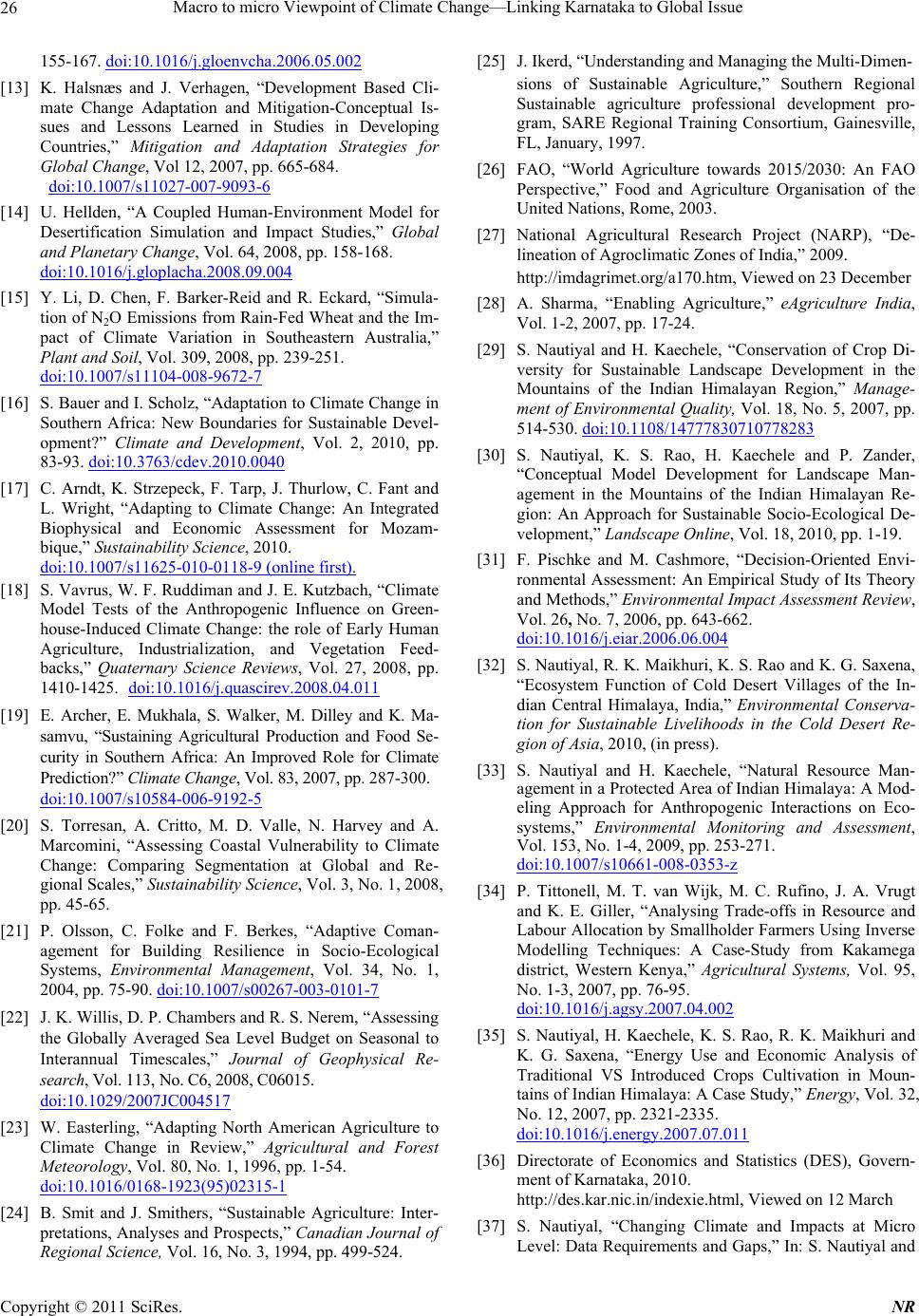
Macro to micro Viewpoint of Climate Change—Linking Karnataka to Global Issue
26
155-167. doi:10.1016/j.gloenvcha.2006.05.002
[13] K. Halsnæs and J. Verhagen, “Development Based Cli-
mate Change Adaptation and Mitigation-Conceptual Is-
sues and Lessons Learned in Studies in Developing
Countries,” Mitigation and Adaptation Strategies for
Global Change, Vol 12, 2007, pp. 665-684.
doi:10.1007/s11027-007-9093-6
[14] U. Hellden, “A Coupled Human-Environment Model for
Desertification Simulation and Impact Studies,” Global
and Planetary Change, Vol. 64, 2008, pp. 158-168.
doi:10.1016/j.gloplacha.2008.09.004
[15] Y. Li, D. Chen, F. Barker-Reid and R. Eckard, “Simula-
tion of N2O Emissions from Rain-Fed Wheat and the Im-
pact of Climate Variation in Southeastern Australia,”
Plant and Soil, Vol. 309, 2008, pp. 239-251.
doi:10.1007/s11104-008-9672-7
[16] S. Bauer and I. Scholz, “Adaptation to Climate Change in
Southern Africa: New Boundaries for Sustainable Devel-
opment?” Climate and Development, Vol. 2, 2010, pp.
83-93. doi:10.3763/cdev.2010.0040
[17] C. Arndt, K. Strzepeck, F. Tarp, J. Thurlow, C. Fant and
L. Wright, “Adapting to Climate Change: An Integrated
Biophysical and Economic Assessment for Mozam-
bique,” Sustainability Science, 2010.
doi:10.1007/s11625-010-0118-9 (online firs t).
[18] S. Vavrus, W. F. Ruddiman and J. E. Kutzbach, “Climate
Model Tests of the Anthropogenic Influence on Green-
house-Induced Climate Change: the role of Early Human
Agriculture, Industrialization, and Vegetation Feed-
backs,” Quaternary Science Reviews, Vol. 27, 2008, pp.
1410-1425. doi:10.1016/j.quascirev.2008.04.011
[19] E. Archer, E. Mukhala, S. Walker, M. Dilley and K. Ma-
samvu, “Sustaining Agricultural Production and Food Se-
curity in Southern Africa: An Improved Role for Climate
Prediction?” Climate Change, Vol. 8 3 , 2 007 , p p. 287-300.
doi:10.1007/s10584-006-9192-5
[20] S. Torresan, A. Critto, M. D. Valle, N. Harvey and A.
Marcomini, “Assessing Coastal Vulnerability to Climate
Change: Comparing Segmentation at Global and Re-
gional Scales,” Sustainability Science, Vol. 3, No. 1, 2008,
pp. 45-65.
[21] P. Olsson, C. Folke and F. Berkes, “Adaptive Coman-
agement for Building Resilience in Socio-Ecological
Systems, Environmental Management, Vol. 34, No. 1,
2004, pp. 75-90. doi:10.1007/s00267-003-0101-7
[22] J. K. Willis, D. P. Chambers and R. S. Nerem, “Assessing
the Globally Averaged Sea Level Budget on Seasonal to
Interannual Timescales,” Journal of Geophysical Re-
search, Vol. 113, No. C6, 2008, C06015.
doi:10.1029/2007JC004517
[23] W. Easterling, “Adapting North American Agriculture to
Climate Change in Review,” Agricultural and Forest
Meteorology, Vol. 80, No. 1, 1996, pp. 1-54.
doi:10.1016/0168-1923(95)02315-1
[24] B. Smit and J. Smithers, “Sustainable Agriculture: Inter-
pretations, Analyses and Prospects,” Canadian Journal of
Regional Science, Vol. 16, No. 3, 1994, pp. 499-524.
[25] J. Ikerd, “Understanding and Managing the Multi-Dimen-
sions of Sustainable Agriculture,” Southern Regional
Sustainable agriculture professional development pro-
gram, SARE Regional Training Consortium, Gainesville,
FL, January, 1997.
[26] FAO, “World Agriculture towards 2015/2030: An FAO
Perspective,” Food and Agriculture Organisation of the
United Nations, Rome, 2003.
[27] National Agricultural Research Project (NARP), “De-
lineation of Agroclimatic Zones of India,” 2009.
http://imdagrimet.org/a170.htm, Viewed on 23 December
[28] A. Sharma, “Enabling Agriculture,” eAgriculture India,
Vol. 1-2, 2007, pp. 17-24.
[29] S. Nautiyal and H. Kaechele, “Conservation of Crop Di-
versity for Sustainable Landscape Development in the
Mountains of the Indian Himalayan Region,” Manage-
ment of Environmental Quality, Vol. 18, No. 5, 2007, pp.
514-530. doi:10.1108/14777830710778283
[30] S. Nautiyal, K. S. Rao, H. Kaechele and P. Zander,
“Conceptual Model Development for Landscape Man-
agement in the Mountains of the Indian Himalayan Re-
gion: An Approach for Sustainable Socio-Ecological De-
velopment,” Landscape Online, Vol. 18, 2010, pp. 1-19.
[31] F. Pischke and M. Cashmore, “Decision-Oriented Envi-
ronmental Assessment: An Empirical Study of Its Theory
and Methods,” Environmental Impact Assessment Review,
Vol. 26, No. 7, 2006, pp. 643-662.
doi:10.1016/j.eiar.2006.06.004
[32] S. Nautiyal, R. K. Maikhuri, K. S. Rao and K. G. Saxena,
“Ecosystem Function of Cold Desert Villages of the In-
dian Central Himalaya, India,” Environmental Conserva-
tion for Sustainable Livelihoods in the Cold Desert Re-
gion of Asia, 2010, (in press).
[33] S. Nautiyal and H. Kaechele, “Natural Resource Man-
agement in a Protected Area of Indian Himalaya: A Mod-
eling Approach for Anthropogenic Interactions on Eco-
systems,” Environmental Monitoring and Assessment,
Vol. 153, No. 1-4, 2009, pp. 253-271.
doi:10.1007/s10661-008-0353-z
[34] P. Tittonell, M. T. van Wijk, M. C. Rufino, J. A. Vrugt
and K. E. Giller, “Analysing Trade-offs in Resource and
Labour Allocation by Smallholder Farmers Using Inverse
Modelling Techniques: A Case-Study from Kakamega
district, Western Kenya,” Agricultural Systems, Vol. 95,
No. 1-3, 2007, pp. 76-95.
doi:10.1016/j.agsy.2007.04.002
[35] S. Nautiyal, H. Kaechele, K. S. Rao, R. K. Maikhuri and
K. G. Saxena, “Energy Use and Economic Analysis of
Traditional VS Introduced Crops Cultivation in Moun-
tains of Indian Himalaya: A Case Study,” Energy, Vol. 32,
No. 12, 2007, pp. 2321-2335.
doi:10.1016/j.energy.2007.07.011
[36] Directorate of Economics and Statistics (DES), Govern-
ment of Karnataka, 2010.
http://des.kar.nic.in/indexie.html, Viewed on 12 March
[37] S. Nautiyal, “Changing Climate and Impacts at Micro
Level: Data Requirements and Gaps,” In: S. Nautiyal and
C
opyright © 2011 SciRes. NR